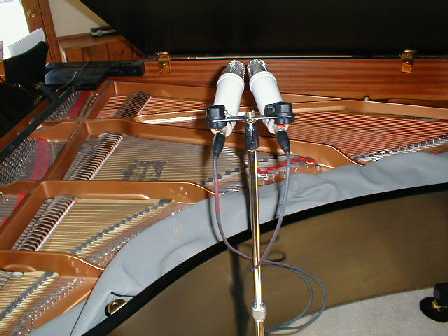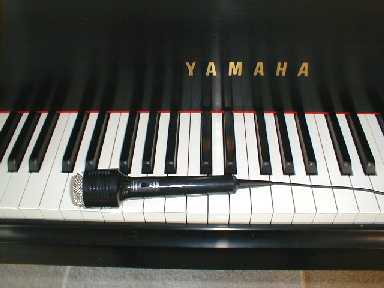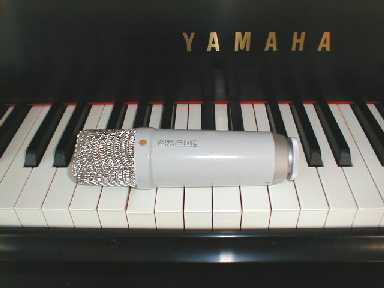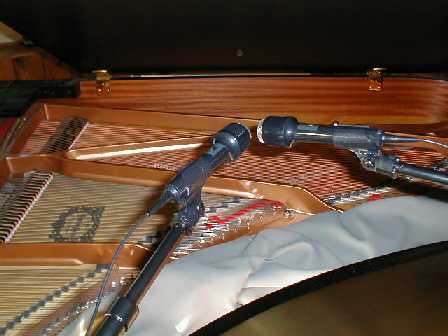Can You Tell The Difference Between A $15 Microphone and a $200 Microphone?
by Ed Ting Updated 1/7/03 The Rode NT-1s ready for action
The Rode NT-1s ready for action
Can you tell the difference between a $15 microphone and a $200 microphone? I was curious to find out. I set up this test, made some simple recordings, and I'll let you decide. There's a link at the bottom that will tell you the result after you've finished listening to the mp3 tracks. No peeking!
The Contestants: Microphone A: Realistic Highball 7 by Radio Shack ($15, NLA)
 The Highball 7
The Highball 7 The Rode NT-1
The Rode NT-1The Test: I set the microphones over the soundboard of my 1999 Yamaha C6 (6' 11") grand piano, doing my best to approximate a 90 degree X-Y configuration. I first played the same track of music through both sets of microphones. Next, I set the mics up (again in X-Y) and spoke some text into them. A foam windscreen was used during the vocal part of the test. Finally, I jangled some keys about 1 foot in front of the microphones. Jangling keys is an acid test for recording chains; few can get this exactly right. The rest of the recording chain consists of a Behringer MX802A mixer, an Echo Audio Darla sound card, and a Dell computer running Cool Edit Pro. Wav files were recorded at 16 bit, 44,000 hz. Mp3 encoding was done by Musicmatch. Cautions: Experienced recording engineers probably have lots of questions at this point, so I'll try to address the problems inherent in a test like this. Yes, there are issues, and I am very aware of them. 1) Gain level. Levels were set using computer-generated tones played through loudspeakers. The mics were set about 1 foot away from my Epos ES11 speakers. This took more time than I expected. The Rode's have a relatively high output, while the Realistics needed a lot of boost (typical of dynamic mics.) Thus, it's possible that you're hearing more of the Behringer's preamp circuitry with the Realistic's tracks. 2) I should note that some people do not care for these Behringer mixers. I do have a Symetrix SX302 mic preamp (which I like a lot, by the way) but it only accepts XLR and Euroblock inputs, which would have made adapting the Radio Shack mics a real pain, so I stuck with the mixer because it's convenient. The Symetrix has a smoother, cleaner output than the Behringer, which seems to impart a slight harshness or grain to the sound. But, hey, what do you want for $100? 3) The tracks are Mp3s. I don't like compressed audio any more than you do, but it was the only way to keep the files down to a managable size. A typical Mp3 contains only 1/10th to 1/12 the information in a typical wav file. Thus, Mp3s tend to mask subtle differences like the ones you're trying to hear. Of all the issues with this test, this one is probably the most serious. I can tell the difference between the mics on these mp3s, but it's easier for me because I've heard the raw wav files so many times.
 The Realistics over the soundboard
The Realistics over the soundboardReady? Here are the tracks. I've tried to keep them fairly short to preserve bandwidth (not to mention listener patience.) The music track is a portion of Chopin's B Major Nocturne, and the spoken text is a sentence from one of my telescope articles. I am an amateur pianist; please make allowances. Mystery Mic #1: